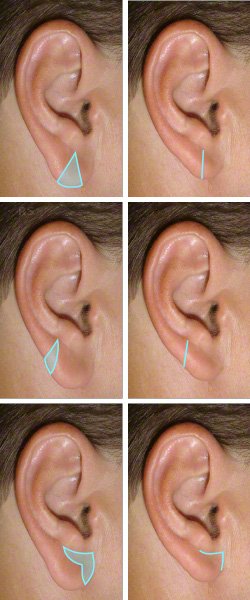Pictures: No before and after pictures of earlobe correction are shown here, but rather graphics illustrating the incision (left) and scarring (right) for various methods of earlobe reduction.
What is earlobe correction all about?
Earlobe corrections are generally rare operations in plastic surgery. However, the demand is more frequent when it comes to torn ear holes, which can be caused by ear jewelry getting stuck or by the weight of earrings that are too heavy. Earlobe reduction or augmentation is also possible, as briefly described below.
Earlobe correction can easily be performed under local anesthesia. The earlobe can be completely anaesthetized with two stitches. Only very anxious patients sometimes require additional sedation.
How does earlobe reduction work?
This type of earlobe correction is used to correct earlobes that are too large, often as part of an ear reduction. Earlobe reduction is also occasionally requested during ear pinning.
During the operation, excess earlobe tissue is precisely marked and removed in a wedge or zigzag shape and then sutured. It is important to achieve perfect symmetry. The sutures must also be sutured in such a way that the scars do not retract when the earlobes are reduced. You can see sketches of possible techniques for this form of earlobe correction in the picture above.
Earlobe augmentation is in vogue.
There are basically two forms of earlobe correction. A technique that is performed with a scalpel and a less invasive method using a syringe.
The surgical method of earlobe augmentation consists of a skin transfer procedure. A skin-fat flap to be lifted is planned under and behind the earlobe. After the flap has been lifted, it is shaped and sewn into place to create the desired earlobe shape. However, this is more of an earlobe reconstruction than a mere earlobe augmentation. This form of earlobe correction is therefore mainly used for severe deformities, accidents or after skin cancer surgery (rare).
Earlobe augmentation for aesthetic reasons is performed using filling materials (e.g. hyaluronic acid). The hyaluronic acid is simply injected into the earlobe to shape and enlarge it. The result lasts for approximately one year. Earlobes that have become overgrown or very small can thus show off the ear jewelry to better advantage.
Earlobe correction for torn ear holes.
The most common earlobe correction is surgery for a tear or sagging earlobes. Wearing heavy ear jewelry for a long time or piercing your ears too low is the cause.
If the ear hole is only sagging, it can be cut out and sewn up before it tears. This keeps the cost of earlobe correction to a minimum.
Torn ear holes often have to be treated with a flap or Z-plasty to ensure a better scar pattern.
When operating on the earlobe, care must be taken to ensure perfect suturing, as the scars can cause retractions if they shrink on the soft earlobe.
Earlobe creation for protruding earlobes.
In connection with ear correction for protruding ears, earlobe correction of protruding earlobes is sometimes also desired. The position of the earlobe can be improved by removing a spindle-shaped area of skin on the back. This type of earlobe structure always makes sense if the earlobe protrudes conspicuously (up to 90 degrees).
What needs to be considered after earlobe correction?
After earlobe correction, a firm plaster bandage is usually sufficient, which can be made to look quite inconspicuous (skin-colored plaster). The stitches should be removed a little later than usual on the face so that the scar has a certain stability. A new ear hole for initially light jewelry should not be pierced before 6 weeks have passed. Your plastic surgeon should do the piercing to prevent unfavorable placement in the area of the scar.
Further information on ear placement.
You will already find some further links in the above text on earlobe correction. Further articles are briefly presented here.
- There are a large number of different ways to surgically correct protruding ears. You can find a brief overview in the article Ear correction methods.
- It is also possible to correct protruding ears without operating on them. However, this is subject to very strict conditions. Basically, the ear cartilage is shaped. You can find more information on this in the article on ear reshaping without surgery. Earlobe correction with protruding earlobes is hardly possible as they do not contain any cartilage.
- There are techniques for the surgery of prominent ears that require very small to almost no incisions. These are often referred to as suture methods, although sutures are used in all techniques. You can read more information under Ear correction with the suture method.
Sources:
- Aesthetic and plastic surgery of the nose, face and auricle – Kastenbauer, Tardy – Thieme – Stuttgart 2005
- Plastic surgery – Krupp – Ecomed – 2008 – (ring binder)
- Surgery of the auricle: Injuries, defects and anomalies – Hilko Weerda – Thieme – Stuttgart 2004


